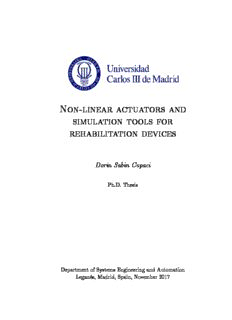Table Of ContentNon-linear actuators and
simulation tools for
rehabilitation devices
Dorin Sabin Copaci
Ph.D. Thesis
Department of Systems Engineering and Automation
Legan(cid:19)es, Madrid, Spain, November 2017
Non-linear actuators and simulation tools for
rehabilitation devices
Candidate
Dorin Sabin Copaci
Advisers
Dolores Blanco Rojas
Luis Moreno Lorente
Review Committee
President: Eduardo Roco(cid:19)n
Secretary: Concepcio(cid:19)nMonje
Vocal: Martin Stoelen
Grade:
Legan(cid:19)es, Madrid, Spain, November 2th, 2017
"I^mi displac^(cid:16)n egal(cid:21)a ma(cid:21)sur(cid:21)a at^at
complicarea inutil(cid:21)a a lucrurilor
simple, c^at (cid:24)si simpli(cid:12)carea f(cid:21)ar(cid:21)a rost
a celor complexe."
i
ii
Preface
Rehabilitation robotics is a (cid:12)eld of research that investigates the applications of
robotics in motor function therapy for recovering the motor control and motor capa-
bility. In general, this type of rehabilitation has been found e(cid:11)ective in therapy for
personssu(cid:11)eringmotordisorders, especiallyduetostrokeorspinalcordinjuries. This
type of devices generally are well tolerated by the patients also being a motivation in
rehabilitation therapy. In the last years the rehabilitation robotics has become more
popular, capturing the attention at various research centers. They focused on the de-
velopment more e(cid:11)ective devices in rehabilitation therapy, with a higher acceptance
factor of patients tacking into account: the (cid:12)nancial cost, weight and comfort of the
device.
Among the rehabilitation devices, an important category is represented by the
rehabilitation exoskeletons, which in addition to the human skeletons help to pro-
tect and support the external human body. This became more popular between the
rehabilitation devices due to the easily adapting with the dynamics of human body,
possibility to use them such as wearable devices and low weight and dimensions which
permit easy transportation.
Nowadays, in the development of any robotic device the simulation tools play an
important role due to their capacity to analyse the expected performance of the sys-
tem designed prior to manufacture. In the development of the rehabilitation devices,
the biomechanical software which is capable to simulate the behaviour interaction
between the human body and the robotics devices, play an important role. This
helps to choose suitable actuators for the rehabilitation device, to evaluate possible
mechanical designs, and to analyse the necessary controls algorithms before being
tested in real systems.
This thesis presents a research proposing an alternative solution for the current
systems of actuation on the exoskeletons for robotic rehabilitation. The proposed
solution, has a direct impact, improving issues like device weight, noise, fabrication
costs, size an patient comfort. In order to reach the desired results, a biomechanical
iii
software based on Biomechanics of Bodies (BoB) simulator where the behaviour of
the human body and the rehabilitation device with his actuators can be analysed,
was developed.
In the context of the main objective of this research, a series of actuators have
been analysed, including solutions between the non-linear actuation systems. Be-
tween these systems, two solutions have been analysed in detail: ultrasonic motors
and Shape Memory Alloy material. Due to the force - weight characteristics of each
device (in simulation with the human body), the Shape Memory Alloy material was
chosen as principal actuator candidate for rehabilitation devices.
The proposed control algorithm for the actuators based on Shape Memory Alloy,
wastestedovervariouscon(cid:12)gurationsofactuatorsdesignandanalysedintermsofen-
ergy e(cid:14)ciency, cooling deformation and movement. For the bioinspirated movements,
such as the muscular group’s biceps-triceps, a control algorithm capable to control
two Shape Memory Alloy based actuators in antagonistic movement, has been devel-
oped.
A segmented exoskeleton based on Shape Memory Alloy actuators for the upper
limb evaluation and rehabilitation therapy was proposed to demosntrate the eligibil-
ity of the actuation system. This is divided in individual rehabilitation devices for
the shoulder, elbow and wrist. The results of this research was tested and validated
intherealelbowexoskeletonwithtwodegreesoffreedomdevelopedduringthisthesis.
iv
Acknowledgments
Many people deserve to appear in these acknowledgments for both personal and pro-
fessional reasons.
Firstly, I would like to thank my supervisors for guiding, challenging, and encour-
aging me during these years. Prof. Dolores Blanco for her patience and guidance
which allowed me to grow, both professionally and personally. Prof. Luis Moreno, for
his encouragement words and comments during these years, which have contributed
to realize and improve this thesis. I have been extreme lucky to have supervisors who
cared so much about my work, and who responded to my questions and queries so
promptly.
My acknowledgements to Prof. James Shippen who allowed me to be part of his
research team during my stage in Coventry University and gave me the possibility to
use his simulator BoB. Also, I must to express my gratitude to Prof. Tetsuya Mouri
which gave me the incredible opportunity to be a visitor in his laboratory in Gifu
University. These experiences I will never forget.
I would like to thanks to the laboratory members, and all the colleges which I met
during my research, for their patience and their opinions which always helped me. I
(cid:19)
cannot forget most sincerely thanks for Angela Nombela, Fernando San Deogracias,
Jose Antonio Campo for their support.
And last, but not least, I want to hugely thanks to my family that has always
been so close to me, even though thousands of kilometers separate us... .
Many thanks to all of them...
v
vi
Description:which gave me the incredible opportunity to be a visitor in his laboratory in Gifu. University. 2.1 Exoskeletons in rehabilitation therapies . In this work a control hardware is based on a 32 bits microcontroller STM32F4.

